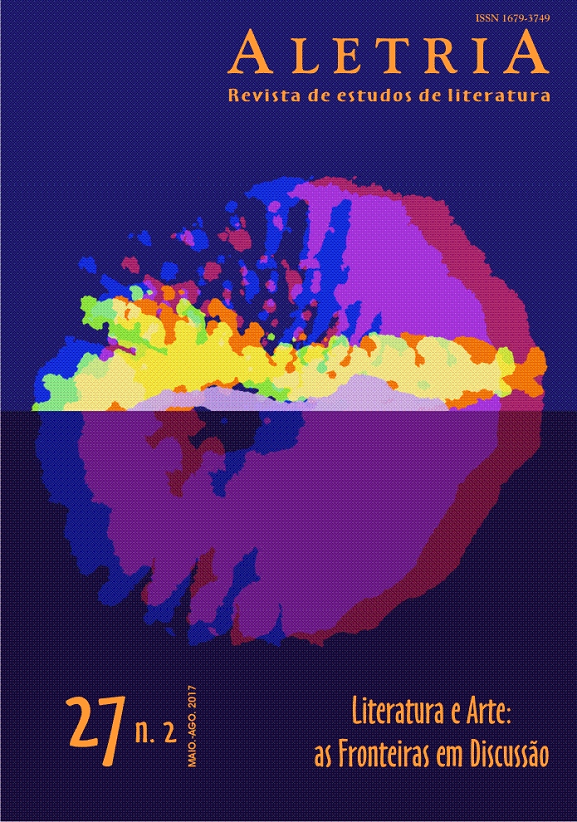Literature and Abstract Art: Clarice Lispector’s Água Viva
DOI:
https://doi.org/10.17851/2317-2096.27.2.261-276Keywords:
literature, abstract painting, Clarice Lispector, Água vivaAbstract
The essay discusses the intermedial relations between art and Clarice Lispector’s Água viva, taking the novel as a literary version of abstract painting. Discarding references to the world of fictional reality, the text almost wholly gives up plot and character, as well as the presence of a narrator. However, by preserving remnants of these elements of traditional fiction, it signals the option for a kind of abstraction which keeps vestiges of recognizable objects and living or imaginary beings, as in certain paintings by Wassily Kandinsky and Manabu Mabe. Such as abstract painting, the novel does not do without a formal organization, which consists in the use of recurrent images, usually associated with water and synaesthetic figures. As a whole, these strategies converge to the resumption of existential themes constant in Clarice’s work: the search for it, the neuter, the thing itself, which lurks under the veil of appearances.
Downloads
References
ANDRADE, Maria das Graças Fonseca. Da escrita de si à escrita fora de si: uma leitura de Objeto gritante e Água viva de Clarice Lispector. 2007. 225 f. Tese (Doutorado em Estudos Literários) – Faculdade de Letras, Universidade Federal de Minas Gerais, Belo Horizonte, 2007.
BAUDELAIRE, Charles. Correspondances. In: BAUDELAIRE, Charles. Les Fleurs du mal. Paris: Poulet-Malassis et De Broise, 1861. p. 15.
BELLAMY, Suzanne. The Visual Arts in To the Lighthouse. In: PEASE, Allison (Ed.). The Cambridge Companion to To the Lighthouse. Cambridge: Cambridge University Press, 2015. p. 136-145.
BRIDEN, Mary. Hélène Cixous and Maria Chvevska. In: KNIGHT, Diana; STILL,Judith (Ed.). Women and Representation: Women Teaching French (Occasional Paper). Nottingham: WIF Publications, 1995. p. 106-114.
GOODING, Mel. Arte abstrata. Tradução de Otacílio Nunes e Valter Pontes. São Paulo: Cosac & Naify, 2002.
IANNACE, Ricardo. Retratos em Clarice Lispector: literatura, pintura e fotografia. Belo Horizonte: Editora UFMG, 2009.
JALES, Suzane. O figurativo abstrato de Naza. Rio de Janeiro: Tiriunvirtatum, 1999.
JONES, Caroline A. Synaesthea. In: JONES, Caroline A (Ed.). Sensorium: Embodied Experience, Technology, and Contemporary Art. Cambridge: MIT, 2006. p. 216-219.
KANDINSKY, Wassily. Blue Mountain. 1908-1909. Óleo sobre tela, 106 x 96.6 cm. Guggenheim Musem. Collection Online. Disponível em: . Acesso em: 13 maio 2017.
LISPECTOR, Clarice. A paixão segundo G.H. Rio de Janeiro: Rocco, [197–].
LISPECTOR, Clarice. Abstrato e figurativo. In: LISPECTOR, Clarice. Para não esquecer. Rio de Janeiro: Rocco, 1999. p. 31.
LISPECTOR, Clarice. Água viva. Rio de Janeiro: Editora Rocco, 1998.
LISPECTOR, Clarice. Correspondências. Organizado por Teresa Montero. Rio de Janeiro: Rocco, 2002.
LISPECTOR, Clarice. Um sopro de vida. Rio de Janeiro: Rocco, 1999.
MIRANDA, Ana Augusta Wanderley Rodrigues de. O indizível: uma leitura em interface com a psicanálise em Clarice Lispector. Vitória: EDUFES, 2012.
OBOUSSIER, Claire. Synaesthesia in Cixous and Barthes. In: KNIGHT, Diana; STILL, Judith (Ed.). Women and Representation: Women Teaching French (Occasional Paper). Nottingham: WIF Publications, 1995. p. 115-131.
PATER, Walter. The Renaissance: Studies in Art and Poetry. London, New York: Macmillan, 1888.
POE, Edgar Allan. Al Aaraaf. In: INGRAM, John H. (Ed.). The Works of Edgar Allan Poe. Edinburgh: Adam and Charles Black, 1875. v. 3: Poems and Essays, p. 36.
PROSE, Francine. The Mrs. Dalloway Reader. San Diego: Harcourt, 2003.
READ, Herbert. O sentido da arte. Tradução de E. Jacy Monteiro. 4. ed. São Paulo: IBRASA, 2005.
READ, Herbert. The Meaning of Art. New York; Washington: Praeger, 1968.
SCHAPIRO, Meyer. The nature of abstract art. In: GAIGER, Jason; WOOD, Paul (Ed.). Art of the Twentieth Century Reader. New Haven: Yale University Press, 2003. p. 22-31.
SEUPHOR, Michel. L’art abstrait. Paris: Maeght, 1974.
VAN CAMPEN, Crétien. The Hidden Sense: Synesthesia in Art and Science. Cambridge: MIT, 2010.
Downloads
Additional Files
Published
How to Cite
Issue
Section
License
Copyright (c) 2017 Solange Ribeiro de Oliveira (Autor)

This work is licensed under a Creative Commons Attribution 4.0 International License.
Authors who publish with this journal agree to the following terms:Authors retain copyright and grant the journal right of first publication with the work simultaneously licensed under a Creative Commons Attribution Non-Commercial No Derivatives License that allows others to share the work with an acknowledgement of the work's authorship and initial publication in this journal.Authors are able to enter into separate, additional contractual arrangements for the non-exclusive distribution of the journal's published version of the work (e.g., post it to an institutional repository or publish it in a book), with an acknowledgement of its initial publication in this journal.Authors are permitted and encouraged to post their work online (e.g., in institutional repositories or on their website) prior to and during the submission process, as it can lead to productive exchanges, as well as earlier and greater citation of published work (See The Effect of Open Access).





